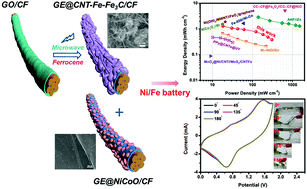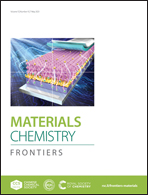Designing a high-performance anode composed of carbon nanotubes and Fe–Fe3C nanoparticles for quasi-solid-state fibrous Ni/Fe batteries†
Abstract
Fiber-shaped energy storage devices (FESDs) are indispensable for developing portable and wearable electronic products. Aqueous rechargeable Ni/Fe batteries are an appropriate candidate due to the cost-effectiveness, high ionic conductivity, and great safety. However, their energy density is still far from satisfactory, hindering further practical applications. Herein, we focused on studying binder-free fibrous electrodes for high-performance FESDs based on rechargeable Ni/Fe batteries. A fast microwave-assisted synthesis method was adopted to grow active materials with a 3D conductive network which is constructed from carbon nanotubes decorated with Fe–Fe3C nanoparticles. Due to the heterogeneous structure, the active materials depicted improved electron/ion transfer, boosting the electrochemical performance of the anode. A flexible Ni/Fe battery is successfully fabricated using the aforementioned anode coupled with a NiCoO-based cathode which is synthesized by electrodeposition and a post-annealing process. Thanks to the special structure of the active materials and the fast redox reaction, the assembled flexible Ni/Fe battery achieved high electrochemical properties with a maximum volumetric specific capacity of 1.61 mA h cm−3 and energy density of 1.28 mW h cm−3. The cycling stability and mechanical flexibility were also tested, which demonstrated the prospects for practical application.



 Please wait while we load your content...
Please wait while we load your content...